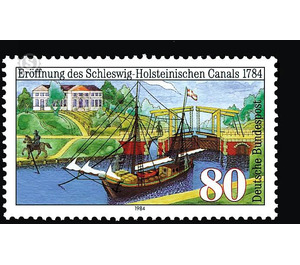200th anniversary of the opening of the Schleswig-Holstein Canal - Germany / Federal Republic of Germany 1984 - 80 Pfennig
Theme: Architecture
| Country | Germany / Federal Republic of Germany |
| Issue Date | 1984 |
| Face Value | 80.00 |
| Color | multi-colored |
| Perforation | K 14 |
| Printing Type | 4-color offset printing |
| Stamp Type | Postage stamp |
| Item Type | Stamp |
| Chronological Issue Number | 1096 |
| Chronological Chapter | GER-BRD |
| Michel ID | BRD 1223 |
| SID | 311821 |
| In 54 Wishlists | |
200 years ago, on 18 October 1784, the Schleswig-Holstein Canal (Eiderkanal) was opened after seven years of construction. He connected the lower reaches of the Eider at Rendsburg with the Kiel Fjord and thus the North Sea with the Baltic Sea. The Schleswig-Holstein Canal (renamed Eider Canal in 1853) was the first artificial waterway between the two seas, which could be sailed by seagoing sailors up to 50 Commerzlasten, ie 121 tons load. He was 3.45 m deep, 17 m at the bottom and 31 m wide at the mirror. Its excavation length was 34 km and its distance to Rendsburg 43 km. The watershed overcame the canal through a total of six locks. To the channel system belonged u. a. the packing houses in Toenning, Rendsburg and Holtenau, brick constructions of considerable size for the goods intended for transhipment. In Rendsburg we also find a stately customs house and a small lock keeper's house. A passage from Holtenau to Toenning (180 km) took three to four days. Sails could be set on the palms or the aft winds; but mostly one was dependent on the trekking with human or horse power. On the Eider, it then went from Rendsburg in the direction Tönning on, however, the tide and tide each inhibited or accelerated the ride. The Schleswig-Holstein Canal, together with its buildings, was the most modern canal of its time and was widely regarded as a technical marvel. With its completion, a long-cherished wish of the shipowners and the merchants came true: the time-consuming and extremely dangerous circumnavigation around the Jutland peninsula, through Skagerrak and Kattegat, could now be avoided. International shipping has made considerable use of this transport route in the following century. 4,000 to 5,000 sailors sailed it in the best years. With the increase in the size of the ship, however, the canal lost more and more its paramount importance. Although the number of ships using it increased until the second half of the nineteenth century, the bulk of the tonnage had to be transported around Skagen and through the Danish Sound to the Baltic Sea. Since the revolutionary year of 1848, there was an increasing emphasis on replacing the Eiderkanal with a larger, more modern waterway, which was to flow into the more suitable channel of the Elbe. This building, the Kiel Canal, was also opened to traffic after a seven-year excavation in 1895; he is today the busiest channel in the world. The Schleswig-Holstein Canal has largely absorbed in him. Today, some idyllic remnants, three preserved locks, the packing houses and the customs house convey an impression of the Schleswig-Holstein Canal (Eider Canal). All of these witnesses are significant monuments of technical achievement and political reformism at the end of the 18th century. (Text: Consul Dr. E. J. Fürsen, 1st Chairman of the Canal Association e.V. in Rendsburg)
| Condition | Name | In Stock | Price | Price + Shipping | Store | |
|---|---|---|---|---|---|---|
 | Unmounted Mint ** | 200th anniversary of the opening of the Schleswig-Holstein Canal - Germany / Federal Republic of Germany 1984 - 80 Pfennig | 10 | US $0.857 | US $4.06 |  FILATELIELOKET (0) FILATELIELOKET (0)Shipping US $3.20 Minimum Order US $2.68 |


